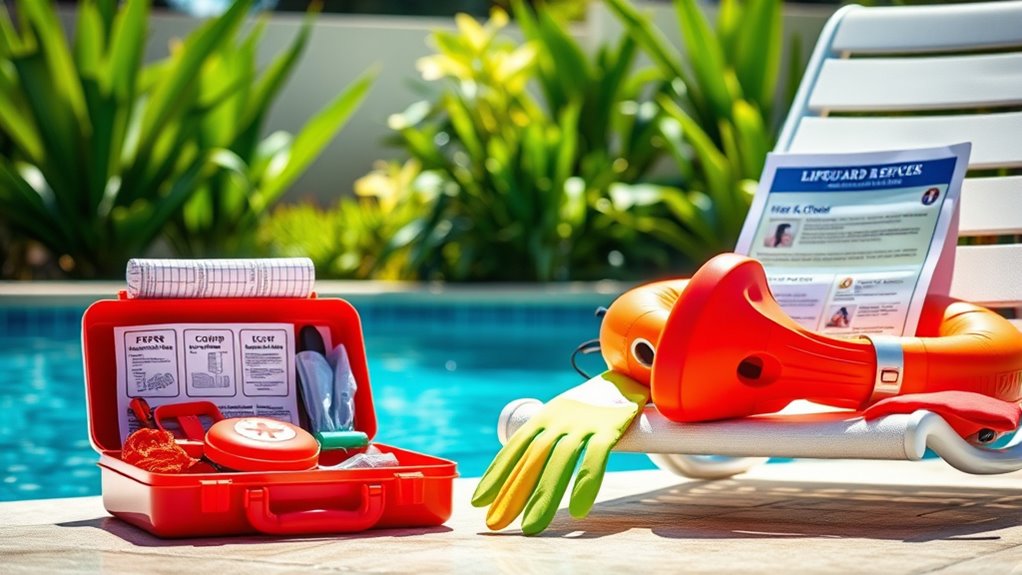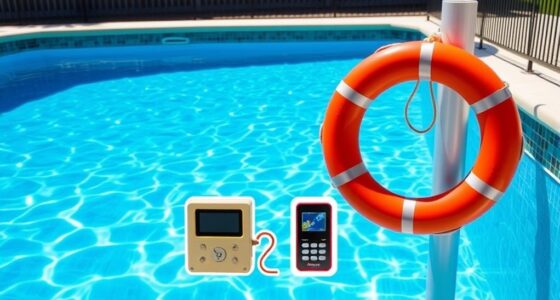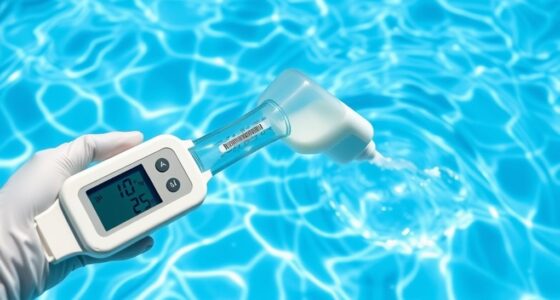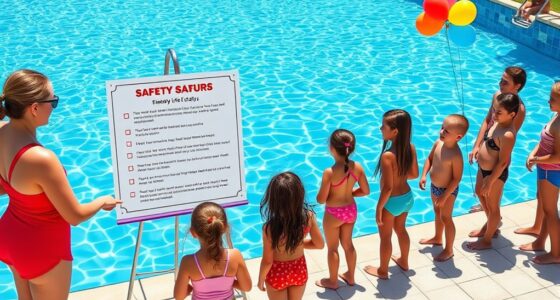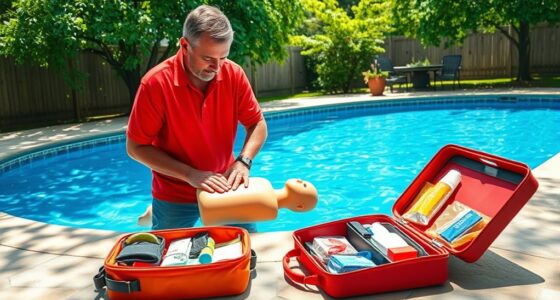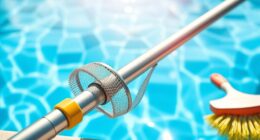As a pool owner, it’s essential to have CPR and first-aid skills to handle emergencies quickly. Make sure you’re ready to recognize signs of distress, perform CPR for adults and children, and treat common injuries like cuts or splinters. Keep a well-stocked first-aid kit nearby and follow safety tips such as constant supervision and proper barriers. If you want to learn the key steps to stay prepared and protect everyone, keep exploring these essentials.
Key Takeaways
- Keep a well-stocked first-aid kit with antiseptics, bandages, tweezers, scissors, and cold packs easily accessible near the pool area.
- Ensure all pool staff and frequent users are trained in CPR and basic first-aid procedures.
- Regularly inspect safety equipment like rescue devices, ladders, and pool covers to prevent accidents.
- Recognize signs of distress early, such as struggling or unresponsiveness, and act promptly with emergency measures.
- Post clear safety signage and educate pool users on emergency protocols and proper responses to injuries.
Recognizing Emergency Situations in the Pool Area
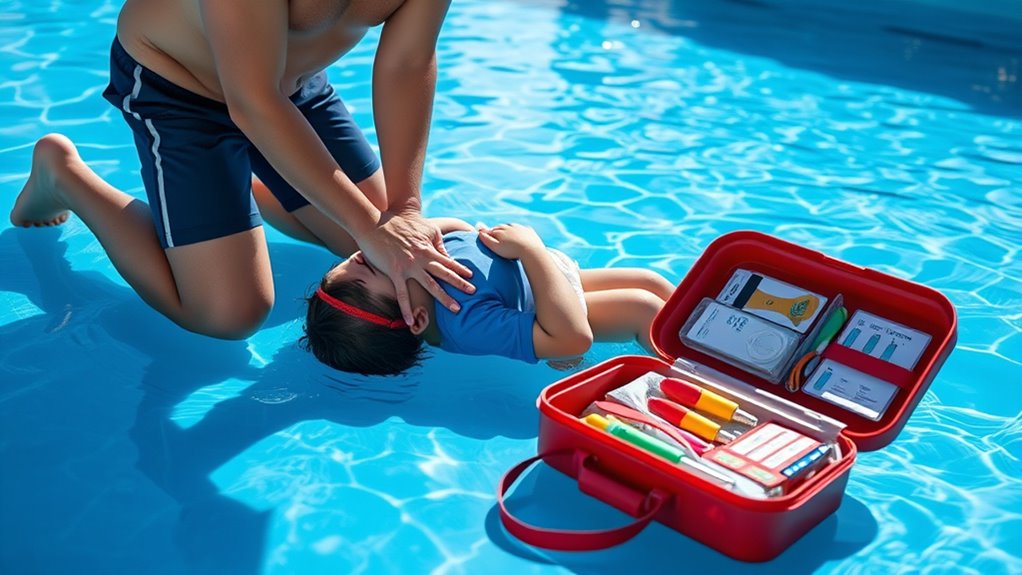
Recognizing emergency situations in the pool area is crucial for ensuring safety and responding quickly when needed. You should stay alert to signs of distress, such as a swimmer struggling, gasping for air, or showing signs of fatigue. Watch for someone who suddenly becomes unresponsive or is floating face-down, which could indicate a drowning incident. Unusual behaviors like frantic movements, splashing, or crying out can also signal trouble. Keep an eye on children and inexperienced swimmers, especially when they’re near the water. Recognizing these signs early allows you to act swiftly, alert others, and initiate emergency procedures. Being attentive and aware helps prevent minor issues from escalating into serious emergencies, ensuring everyone’s safety around the pool. Monitoring the vacuums used for cleaning can help maintain a safe environment by reducing debris and hazards that might cause slips or accidents. Additionally, understanding CPR techniques is vital in providing immediate aid until professional help arrives. Learning about first-aid essentials can further improve your response effectiveness during emergencies. Educating yourself about pool safety protocols can further improve response times and overall safety measures. Staying informed about emergency response procedures enhances preparedness and can make a significant difference in critical situations.
Performing CPR on Adults and Children
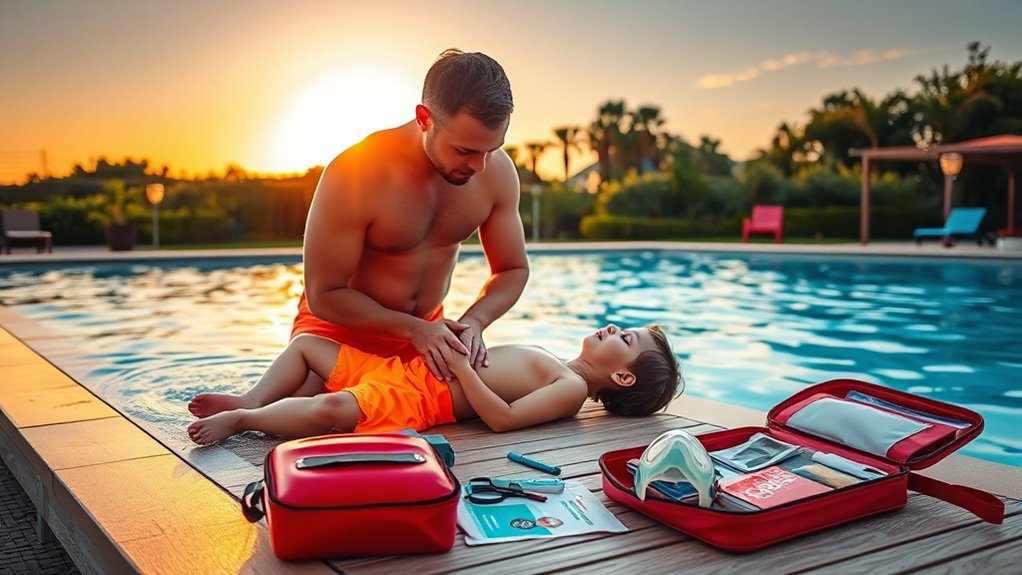
Performing CPR promptly can be life-saving when someone, whether adult or child, stops breathing or their heart ceases to beat. First, check for responsiveness by gently shaking them and shouting. If unresponsive, call 911 immediately or have someone do it. Next, open the airway by tilting the head back slightly and lifting the chin. Pinch the nose shut and give two rescue breaths if you’re trained, watching for the chest to rise. Then, begin chest compressions: place your hands in the center of the chest and push hard and fast at a rate of about 100 to 120 compressions per minute. Continue cycles of 30 compressions and 2 breaths until help arrives or the person shows signs of life. Staying calm and focused is essential to maximize effectiveness and ensure proper technique. Understanding vital signs can also help responders remain centered during emergencies, promoting clearer decision-making under pressure.
Basic First-Aid for Common Pool-Related Injuries
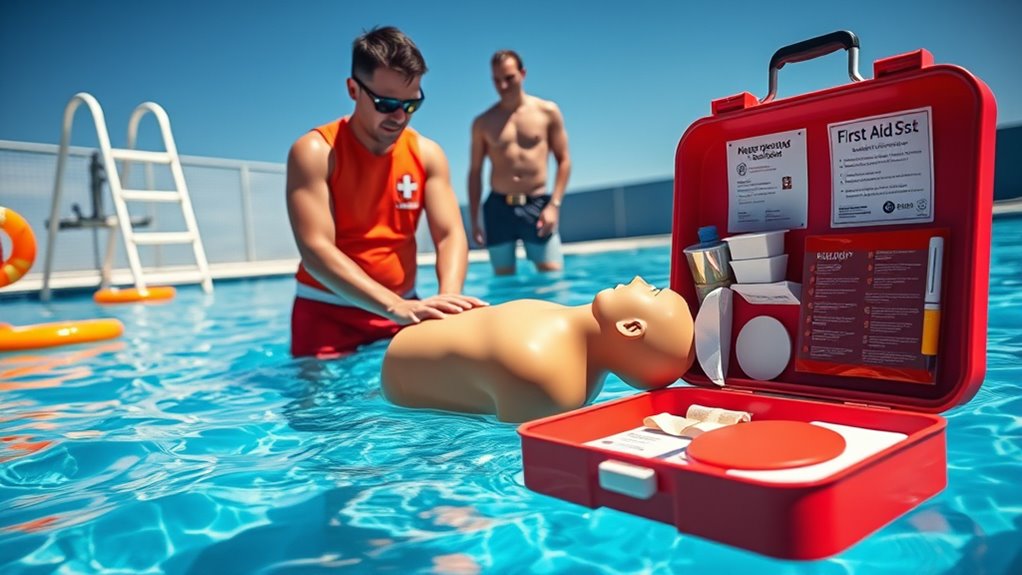
After ensuring CPR is performed if needed, knowing how to provide basic first-aid for common pool-related injuries can make a significant difference in the outcome. Cuts and scrapes are frequent; rinse with clean water, apply antiseptic, and cover with a sterile bandage. For splinters, carefully remove with tweezers after sterilizing them. If someone experiences dizziness or cramping, encourage rest, hydration, and gentle stretching. Proper indoor air quality management contributed by heat pumps can also promote overall health and comfort in your home. Staying informed about emergency response techniques enhances your ability to handle unexpected situations effectively. Recognizing the importance of fatherhood in teaching safety and care can further prepare you for responsible pool ownership. Here’s a quick reference:
| Injury | First-Aid Action |
|---|---|
| Cuts/Scrapes | Clean, disinfect, cover with sterile bandage |
| Splinters | Sterilize tweezers, carefully remove |
| Dizziness/Cramping | Rest, hydrate, stretch gently |
Being prepared to handle these injuries helps keep everyone safe and comfortable around your pool.
Safety Tips to Prevent Accidents and Emergencies
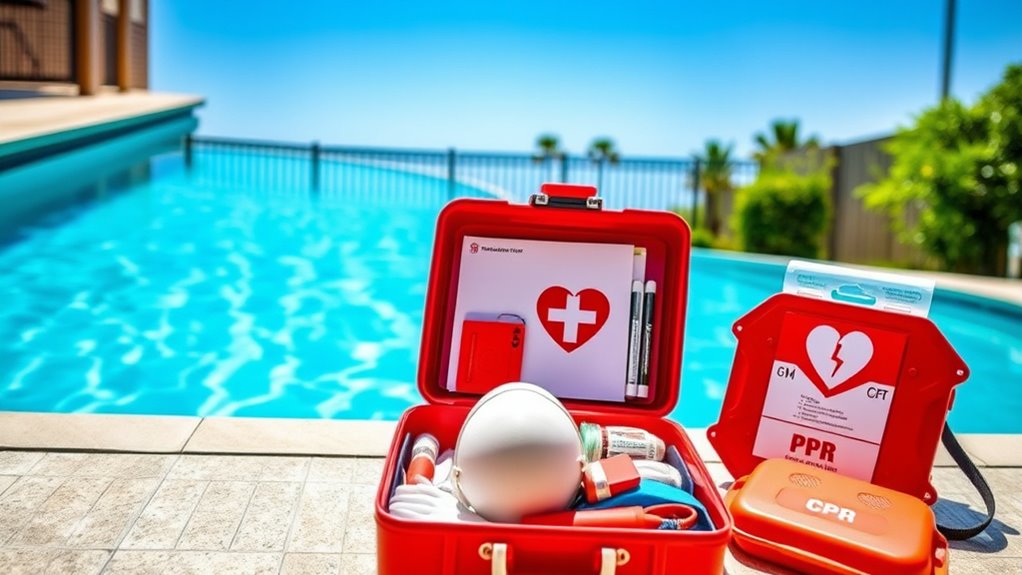
To prevent accidents and emergencies around your pool, it’s essential to implement proactive safety measures. Constantly supervise children and inexperienced swimmers, never leaving them unattended. Install barriers like fencing with a self-latching gate to restrict access when you’re not around. Keep pool covers secured and ensure ladders are stable and removed when the pool isn’t in use. Clearly mark depth levels and keep rescue equipment, such as life rings and a reaching pole, nearby. Regularly maintain the pool’s equipment and check for hazards like slippery surfaces or exposed wiring. Educate everyone about pool rules and safe behavior. Staying vigilant and prepared minimizes risks, helping guarantee a safe swimming environment for everyone. Familiarize yourself with safety regulations and best practices to ensure comprehensive protection. Incorporating AI-powered safety monitoring systems can further enhance your pool’s safety by providing real-time alerts and surveillance. Additionally, reviewing emergency response procedures regularly will ensure everyone knows how to act swiftly in case of an incident. Conducting regular safety drills can also reinforce proper responses during emergencies, making sure all swimmers know what to do. Implementing visual safety signage around the pool area can also improve awareness of potential hazards and safety rules.
Essential First-Aid Kit Items for Pool Safety

Having a well-stocked first-aid kit is essential for pool safety, as accidents can happen unexpectedly. You should include basic supplies like antiseptic wipes, adhesive bandages in various sizes, and sterile gauze pads to treat cuts and scrapes promptly. You have tweezers on hand to remove splinters or debris from the skin. Keep an instant cold pack ready to reduce swelling from bumps or sprains. Include scissors for cutting tape or clothing if needed. It’s also wise to have a thermometer to check for fever or hypothermia, and gloves to protect yourself when helping someone injured. Additionally, incorporating AI-powered sentiment analysis tools can help monitor and respond to emergency situations more effectively. Being aware of vehicle tuning options, such as ECU remapping or suspension upgrades, can be beneficial in other contexts of safety and preparedness. Regularly checking the retail hours of local stores ensures you can restock supplies when needed, avoiding last-minute shortages. Also, ensuring that your first-aid training is up-to-date can improve response times and effectiveness during emergencies. Finally, keep emergency contact numbers visible and ensure everyone knows where the kit is stored. Being prepared minimizes risks and helps you respond quickly during emergencies.
Frequently Asked Questions
When Should I Call Emergency Services During a Pool Incident?
When you face a pool incident, you should call emergency services immediately if someone isn’t breathing, is unresponsive, or has sustained severe injuries. Don’t wait to assess the situation—you need professional help fast. If the situation worsens or you’re unsure about the severity, it’s better to be safe and call. Quick action can save lives, so trust your judgment and contact emergency responders whenever you feel it’s necessary.
How Often Should I Update My CPR and First-Aid Training?
Did you know that over 80% of CPR-trained individuals forget key skills within a few months? That’s why it’s vital to update your CPR and first-aid training at least every two years. Regular refreshers help you stay confident and ready to act in emergencies. By staying current, you make sure you’re prepared to respond effectively, potentially saving a life if an incident occurs at your pool or elsewhere.
What Are Signs of Secondary Drowning After Pool Exposure?
You should watch for signs of secondary drowning after pool exposure, especially if someone has had trouble breathing or swallowed water. Look for symptoms like coughing, chest pain, shortness of breath, or fatigue that worsens over time. If you notice these, seek medical help immediately. Secondary drowning can be serious, so acting quickly can prevent complications and guarantee the person gets the care they need.
Are There Specific First-Aid Procedures for Chemical Pool Injuries?
A stitch in time saves nine, so knowing first-aid for chemical pool injuries is vital. If someone gets chemicals in their eyes or on their skin, rinse immediately with plenty of water for at least 15 minutes. Remove contaminated clothing and avoid neutralizing chemicals. Seek medical attention promptly, especially if irritation persists. Quick, calm action can prevent serious damage and promote faster recovery.
How Can I Effectively Teach Children Pool Safety and Emergency Response?
To teach children pool safety and emergency response effectively, you should start with simple, clear instructions and demonstrate safety rules consistently. Use age-appropriate lessons, such as emphasizing never swimming alone, staying within designated areas, and recognizing danger signals. Practice emergency scenarios regularly, like calling for help or using safety equipment. Keep communication fun and engaging, so children understand safety is important and feel confident to respond appropriately when needed.
Conclusion
By knowing how to recognize emergencies, perform CPR, and handle common injuries, you’re better prepared to keep your pool safe. Remember, drowning is a leading cause of accidental death among children under five, highlighting the importance of quick action. With the right skills and a well-stocked first-aid kit, you can prevent minor issues from turning into tragedies. Stay vigilant, prepared, and confident—your quick response can make all the difference.
